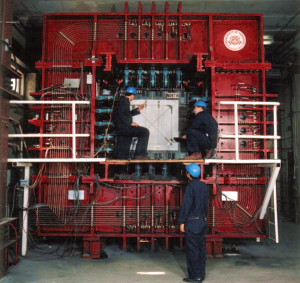A high capacity and full-size panel tester has been established in 1988 at the University of Houston. It can perform biaxial or triaxial tests on reinforced concrete panels 1.4 m square and up to 0.4 m thick. Each panel represents an element cut out from large structures, such as shear walls, bridges, shell roofs, nuclear containment structures and concrete offshore platforms. All types of loading on the element, such as compression, tension, shear, bending, torsion and their combinations can be simulated.
This universal element tester consists of forty in-plane jacks of 100-ton each and twenty out-of-plane jacks of 60-ton each, housed in a giant 16 ft by 16 ft (5-m by 5-m) steel frame. It was constructed to test full-size concrete panels 55 in. (1.397 m) square and up to 16 in. (406 mm) thick reinforced with steel bars from 3/8 to 1 in. (10 to 25 mm) in diameter. Any self-equilibrium loading condition on the four edges of a test panel can be simulated. The panel can be subjected simultaneously to in-plane tension or compression, in-plane and out-of-plane bending, in-plane and out-of-plane shear, as well as torsion. The jacks are individually controlled by a servo-controlled hydraulic system consisting of a 5,000 psi pump, a control board with 60 four-way valves, 0.7 km of hardline steel tubes and high-pressure hoses, and a servo control system. The servo control system was installed in 1993 at a cost of $124,000. It has ten channels, each consisting of a servo-valve, a manifold with 10 pairs of outlets, a pair of Delta P pressure transducers, and a servo controller. This servo control system allows the tests to be performed in either the strain-control mode or the load-control mode.
In 1994, a new data management system was added to enhance the servo control capability. The new system includes 64 signal conditioners, 64 channels of storage, a Compaq 486-33 computer, and a custom-designed software. It provides mode-switch capability between strain-control mode and load-control mode, as well as real-time analysis and graphing capability.
The construction of full-size panel tester at a cost of this $650,000 was sponsored jointly by the National Science Foundation and the Texas Advanced Research Program. This facility is the only one of its type in the United States, and is currently one of the two available in the world. Compared to the other one in Canada, this one is more versatile because it can simulate any self-equilibrium stress condition at the four edges of a panel. It is also capable of performing strain-control tests and applying any prescribed types of cyclic loading beyond the yield point.
